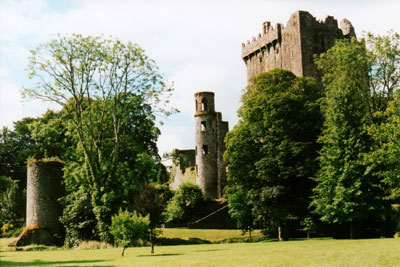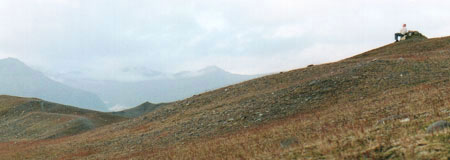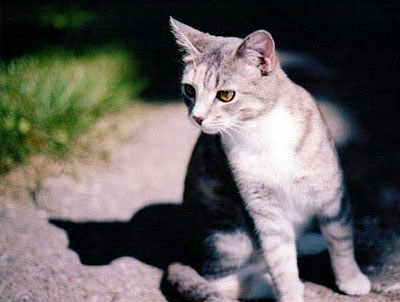AnandTech Guide to Better Photos: Composition
by Stephen Caston on November 19, 2004 12:05 AM EST- Posted in
- Digital Camera
Balance and Space
Now, we are going to take a look at balancing different elements in your composition. It is important to be aware of the "weight" that objects have in a picture. By "weight", we are referring to the attention that each object receives from the viewer. Weight can be affected by the color, size, tone, etc. of the elements in your pictures. For example, in a picture with all black and white objects, a red strawberry will receive the most attention. When you take a picture with several elements, you should be aware of the balance created by the weight of these elements. In general, people prefer pictures that appear to have some sort of balance to them. Additionally, quite often the most obvious balancing methods are also the most boring.
In the image above, the larger (and mostly hidden) castle on the right is balanced with the smaller structure on the left side. The size difference in this balanced image creates an interesting dynamic. If you think of the middle castle as the fulcrum, you can see how the smaller subject on the left is able to balance the large castle on the right by being positioned further from the center.
We also want to talk about the effects of using space as a balancing element. Using space in pictures is often a welcomed change from the "fill the frame" approach.

In the image above, we have offset the subject sitting on a rock at the upper-right with the open space of mountains on the left. Notice how this arrangement can create an atmosphere of contemplation or isolation. In general, space can be used to evoke the imagination of the viewer. For example, "leading" space can be used to give the impression of movement. This is done by leaving extra space in the direction that a subject is facing.

By positioning this ladybug at the lower left of the frame, we were able to give the viewer the impression of movement. Also, notice that by selecting a large aperture opening, we were able to blur the distracting background elements. "Leading" space is a common-sense concept that is also used by movie directors to give the audience an idea of where a character is headed. A good example of the importance of leading space can be seen in horror films. You know something bad is going to happen when a character is backing up, yet there is no leading space to show where he/she is going. In this sense, the inclusion of leading space in the frame can be a comfort to the audience.

Here, we chose to leave some empty space in the frame opposite the cat. If the space on the left were cropped out or simply not included in the shot, the picture would have a very awkward appearance. By allowing for some empty space in the direction of the cat's gaze, we were able to provide a better balance and a far more intriguing picture. As you can see, balance can play a very important role in the effectiveness of pictures. We really want to stress that although space is commonly neglected as a compositional tool, it can be very powerful.










25 Comments
View All Comments
Maverick2002 - Friday, November 19, 2004 - link
I have to agree with #5. It's a good beginner's guide, nothing more.Jeff7181 - Friday, November 19, 2004 - link
I found it very informative... like #10, I find my pictures are usually boring and I'm not creative at all. Most photography sites don't discuss the basics of composition. The pictures I take that turn out good are mostly by accident... I'm the type who centers whatever I'm taking a picture of and snaps the picture. Or if I'm taking a picture of something larger like a landscape, I just point and shoot without giving much thought to what's in the picture. I'm not REALLY into photography obviously, but when I do take pictures I'd like them to look nice.yelo333 - Friday, November 19, 2004 - link
Very nice pointers...do you happen to have higher res versions of the photos? I especially liked the ladybug&stop sign for some reason...If you don't mind emailing them(I'd only use them for personal use, like wallpaper), my email is gmeena at gmail dot com.
WooDaddy - Friday, November 19, 2004 - link
#11 said it.This is who the article was for. Not the rest of us camera jockeys who can go through a roll of 36 in 30 minutes.
CurtOien, if you really want to get into it, take a camera course at your local community college. Also, check out "Photography" by Barbara London. It's the photography student's textbook.
And remember, just keep on taking pictures and examining them. That's how you get good at it.
CurtOien - Friday, November 19, 2004 - link
I’m not a professional photographer or even close to it. I very much appreciated the article. It makes me want to go out and buy a digital camera It costs too much money to click away and experiment with film.ChrisSwede - Friday, November 19, 2004 - link
I agree with #5 that this will not make you a professional photographer. But, for someone like me that struggle to take good pictures and do not have a single creative/artistic bone in me, it gives me some hints on how to improve picture quality and get a little excited about taking pictures./Chris
Calin - Friday, November 19, 2004 - link
#5, you are completely right. However, I am glad for this article as I didn't knew not even a single thing in it. Yes, I am not a photographerCalin
skunklet - Friday, November 19, 2004 - link
i was hoping u guys gave up on these photography articles...kcma - Friday, November 19, 2004 - link
#6brilliant idea!! eat the mattress!! i like them BBQed.
Dustswirl - Friday, November 19, 2004 - link
You can't explain how to sleep to an insomniac but you can show him a bed.